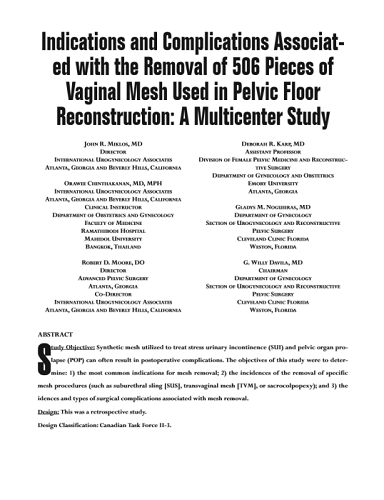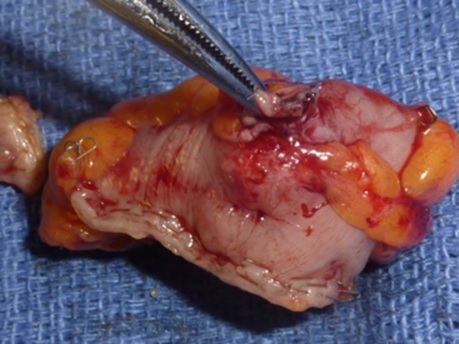WHAT ARE THE SIGNS AND SYMPTOMS OF MESH EROSIONS?
Mesh erosion means the mesh has migrated into a neighboring organ such as the urethra, bladder or rectum. Migration or erosion into each organ will cause specific symptoms and cause the patient to present with symptoms specific to that organ. The most common signs and symptoms are:
Urethral Pain/Burning – with mesh urethral erosion.
Bladder Pain/Burning – with mesh bladder erosion.
Bloody Urine (Hematuria) – can occur with urethral or bladder mesh erosion.
Rectal Pain/Burning – can occur with mesh erosion into the rectum.
Rectal Bleed or Bloody Stool– can occur with rectal mesh erosion.
Painful intercourse – can occur with any of the above mesh erosions ie. urethra, bladder, rectum or bowel.
WHY CHOOSE MIKLOS & MOORE UROGYNECOLOGY TO REPAIR MESH EROSION?
Dr. Miklos is a highly experienced and skilled surgeon who specializes in the treatment of mesh complications. He has removed more than 1,000 pieces of mesh and has been removing mesh since 1994. Few surgeons in the world can make this claim. At Dr. Miklos has a patient-centered approach to care and listens to the patient’s point of view which is not always supported by the scientific literature. He takes the time to thoroughly evaluate each patient’s unique situation and develop a personalized treatment plan and make recommendations based upon her history, symptoms and examination. However, it is the patient who will make the final decision when proceeding with surgery. Dr. Miklos truly believes that he makes the patient an informed consumer so she can ultimately make the right decision to minimize or stop the patient’s pain and suffering. Overall, choosing Dr. Miklos for your mesh complication surgery can provide you with the expert care and support you need to achieve the best possible outcome. Dr Miklos has:
EXPERIENCE -First and foremost at Miklos & Moore Urogynecology the doctors listen. They have been removing mesh since 1998 and have seen, treated, or removed just about every type of transvaginal mesh and its related complications known to man. They have removed more than 1000 pieces of mesh with minimal complications and superior success. (Figure 2)
EXPERTISE – He has treated patients from all over the world for mesh complications. They have produced award-winning videos which have gotten them international acclaim for his mesh-removing technique. Dr. Miklos has taught post-graduate courses for mesh removal at conferences in the USA, Africa, Europe, Netherlands and Australia. He has been referred patients from professors from Harvard, Cleveland Clinic and Mayo Clinic.
KNOWLEDGE – He was a Rule 26 medical legal expert in the MDL (Multi District Litigation) lawsuits which has inundated the internet and television commercials over the last decade. He understands some of the practical issues involving the law and malpractice cases facing patients today. He is also a leader in the world on mesh complications as he has written some of the largest papers on mesh complications found in the worldwide literature. (Figure 1)
RESULTS – Miklos & Moore Urogynecology have addressed and removed some of the most difficult transvaginal mesh devices made and inserted in the human body. Though no one can guarantee the success rate for fixing the patient’s symptoms, Dr. Miklos can usually remove >95% of the mesh load > 90% of the time. He can totally remove the complete implant most of the time if it is indicated.
Here at Miklos & Moore Urogynecology, we have removed approximately 1000 pieces of vaginal mesh devices. When removing these devices, it is usually important to remove as much mesh as possible, especially from the soft tissue (ie. vagina and pelvic floor muscles) in patients suffering from chronic pain. Dr. Miklos has removed transvaginal mesh which has eroded into the neighboring organs such as the urethra, (Video 1) bladder, small intestines and rectum. (Video 2)
RECOVERY TIME AFTER MESH EROSION REPAIR??
Recovery time is dependent upon the amount of eroded mesh removed as well as the location and needed concurrent reconstructive surgery was performed. In general, if the patient is getting a mesh removal, the patient is free to return to normal activity in 6 weeks.
However, if a patient is getting mesh erosion removal and is going to have concurrent reconstructive vaginal surgery, most likely their recovery will take 12 weeks. This does not mean the patient will have pain the whole time, what it means is the reconstructive surgery will need time to heal and scar in place.
TVT sling Urethral Erosion
Posterior Vaginal Wall Mesh Removal for Rectal Erosion & Pelvic Pain



